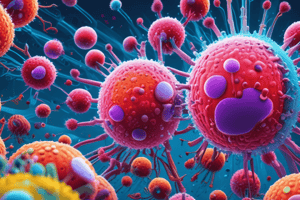Podcast
Questions and Answers
How does a virus differ from a bacterium in terms of reproduction?
How does a virus differ from a bacterium in terms of reproduction?
- Viruses reproduce through binary fission, while bacteria require a host cell.
- Viruses replicate by injecting RNA, while bacteria reproduces by injecting viral proteins.
- Viruses reproduce independently, while bacteria always require a host cell to reproduce.
- Viruses require a host cell to reproduce, while bacteria can reproduce independently. (correct)
A researcher wants to visualize the surface structures of a newly discovered virus. Which type of microscopy would be most suitable?
A researcher wants to visualize the surface structures of a newly discovered virus. Which type of microscopy would be most suitable?
- Brightfield microscopy
- Transmission electron microscopy (TEM)
- Atomic force microscopy
- Scanning electron microscopy (SEM) (correct)
Which of the following characteristics is unique to viroids?
Which of the following characteristics is unique to viroids?
- Ability to integrate into the host genome
- Infection of animal cells
- Composition of only RNA (correct)
- Presence of a capsid
Why are antibiotics ineffective against viral infections?
Why are antibiotics ineffective against viral infections?
A lab technician is preparing to use an electron microscope. Which of the following considerations is most critical?
A lab technician is preparing to use an electron microscope. Which of the following considerations is most critical?
Flashcards
Electron Microscope
Electron Microscope
Microscope using electron beams for high magnification.
TEM (Transmission Electron Microscope)
TEM (Transmission Electron Microscope)
Shows 2D internal details, electrons pass through the sample.
SEM (Scanning Electron Microscope)
SEM (Scanning Electron Microscope)
Views the surface in 3D using electron beams.
Virus
Virus
Signup and view all the flashcards
Viroid
Viroid
Signup and view all the flashcards
Study Notes
- Electron microscopes have two types: transmission (TEM) and scanning (SEM).
- Electron microscopes magnify up to 100,000x.
- Electron microscopes cannot view living specimens.
- Electron microscopes produce black and white images.
- TEM shows 2D images; SEM shows 3D surface views.
- Atomic Force Microscope can view individual atoms.
- Atomic Force Microscope has highest resolution of all microscopes.
Viruses
- Viruses structure consists of a protein coat (capsid) with nucleic acid center.
- Some viruses have an additional envelope layer.
- Viruses reproduce by hijacking host cells.
- Virus reproduction steps: attachment, penetration, biosynthesis/assembly, release.
- Viruses can be latent through incorporation of DNA into host genome.
- Viruses are prevented through vaccines, not treated with antibiotics.
Viroids
- Viroids consist only of RNA.
- Viroids infect only plants.
- Viroids cause plant diseases.
Studying That Suits You
Use AI to generate personalized quizzes and flashcards to suit your learning preferences.




